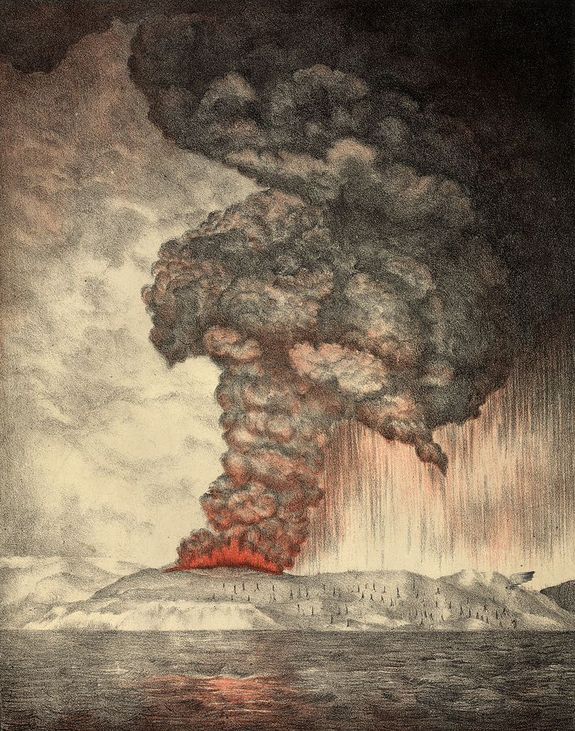The Krakatoa eruptions created some of the most powerful explosions ever experienced. The resulting shockwaves and tsunamis killed more than 36,000 people and were felt hundreds of miles away. In addition, the explosions changed weather patterns around the world for several years.
 Rumblings were first noticed on the Indonesian island of Krakatoa in May 1883. The island's three volcanos were Perboewatan, Danan, and Rakata. Nearby sailors noticed steam venting from Perboewatan on May 20. No activity was recorded on the other two volcanoes until August, when all three were observed to be active.
Rumblings were first noticed on the Indonesian island of Krakatoa in May 1883. The island's three volcanos were Perboewatan, Danan, and Rakata. Nearby sailors noticed steam venting from Perboewatan on May 20. No activity was recorded on the other two volcanoes until August, when all three were observed to be active.
A chain events that began on August 25 resulted in a massive chain reaction, culminating in four enormous explosions on August 27, between 5:30 a.m and 11 a.m. The largest explosion, which occurred at 10:02 a.m., was heard in Perth, Australia, nearly 2,000 miles away, and in Rodrigues, a tiny Indian Ocean island that was 3,000 miles away. Closer in, sailors on ships just a few dozen miles away reported broken eardrums as a result of the explosions.
Some scientists reported barograph readings showing that the shockwaves from the explosions circled the planet seven times. Other scientists estimated that the energy released from the largest explosion was equal to about 200 megatons of TNT. (The atomic explosions over Japan near the end of World War II were equal to about 20 kilotons.)
A landslide, occurring at 10:41 a.m., ripped off half of the Rakata volcano, triggering the final explosion. The explosions sent hot ash spewing into the sky. A cloud of hot ash dropped on nearby Sumatra (30 miles away), killing about 1,000 people.
Each of the four explosions was followed by a tsunami, the largest of which had water that was nearly 100 feet high. Tsunamis spread both westward and eastward, destroying ships, beaches, and even towns, killing thousands of people. One island just a dozen miles away vanished in a wave of water, killing 3,000 people.
Northern Hemisphere locations recorded unusual weather patterns for the next few years. An intense burst of sulfur dioxide from the eruptions created a global increase in sulfuric acid, resulting in a higher amount of cloud reflectivity and, hence, lower temperatures. Many areas in the world reported temperatures more than 1 degree lower for up to five years. Southern California reported a "water year," a period of intense rainfall that lasted until June 1884. People all over the world reported very red sunsets, green sunrises, and an unusually blue (and even green) Moon.
Other locales reported ash clouds that stayed in the sky for weeks at a time. One source even put forward the claim that the famed 1893 painting The Scream depicted the sky over Norway as a result of the Krakatoa explosions.
People in areas that were not immediately affected by the explosions heard about those explosions within a day or so, thanks to the expansion of use of the relatively new invention the telegraph.
As for Krakatoa itself, not much was left. Two-thirds of the island had disappeared, either blown away by the eruptions or swept away by the surrounding waves.